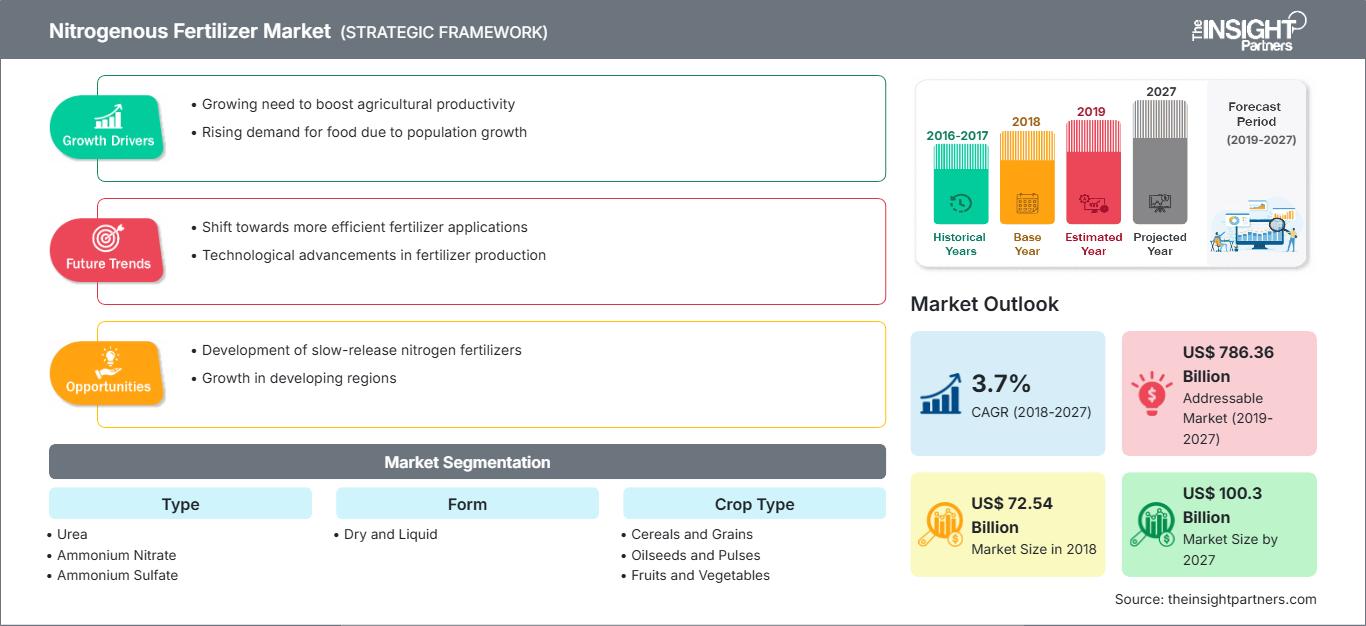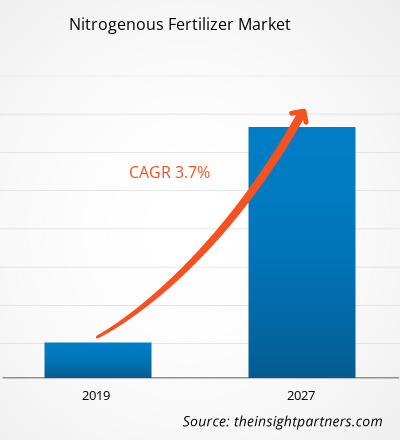El mercado de fertilizantes nitrogenados se valoró en US$ 72.537,57 millones en 2018 y se espera que crezca a una CAGR del 3,7% entre 2019 y 2027 para alcanzar los US$ 100.304,42 millones en 2027.
El fertilizante nitrogenado se produce utilizando nitrógeno del aire, el cual se expone a una compleja reacción química. El nitrógeno se utiliza para promover el crecimiento de los cultivos, mejorar la textura y el color de las plantas y, por lo tanto, contribuye a mejorar la productividad agrícola. El proceso Haber Bosch se considera la técnica preferida para la producción de fertilizantes nitrogenados en el mercado. El gas natural es una de las materias primas más importantes, utilizada en el proceso Haber Bosch junto con otras materias primas como el estiércol animal y el compost, entre otras. El aumento de la población ha incrementado la demanda de seguridad alimentaria y, por lo tanto, impulsa la necesidad de utilizar estos fertilizantes para suministrar nutrientes esenciales al suelo y promover su calidad, lo que en última instancia conduce a mayores rendimientos.
Se espera que el mercado de fertilizantes nitrogenados en Norteamérica alcance su mayor tasa de crecimiento anual compuesto (TCAC) durante el período de pronóstico. Norteamérica es el mercado de mayor crecimiento para este tipo de fertilizantes debido al aumento de su aplicación, respaldado por medidas gubernamentales positivas para impulsar el crecimiento de la industria. Además, es probable que el aumento de la renta disponible, junto con una mayor inversión en mejores instalaciones agrícolas, impulse la demanda de fertilizantes nitrogenados en el mercado norteamericano. Sin embargo, los riesgos ambientales y para la salud que plantea el uso de estos fertilizantes sintéticos han impulsado un mayor uso de productos agrícolas orgánicos. Esto podría frenar el crecimiento del mercado de fertilizantes nitrogenados.
Recibirá personalización de cualquier informe, sin cargo, incluidas partes de este informe o análisis a nivel de país, paquete de datos de Excel, y además aprovechará grandes ofertas y descuentos para empresas emergentes y universidades.
Mercado de fertilizantes nitrogenados: Perspectivas estratégicas

-
Obtenga las principales tendencias clave del mercado de este informe.Esta muestra GRATUITA incluirá análisis de datos, desde tendencias del mercado hasta estimaciones y pronósticos.
Perspectivas del mercado
Crecimiento de la agricultura comercial
La agricultura comercial se define básicamente como el cultivo de cosechas para la venta rentable de los productos en el mercado nacional o de exportación. La agricultura comercial se ha reformado e iniciado una evolución gradual en el sector agrícola. El aumento de la población, sumado al uso de tecnología mejorada y mejores infraestructuras, ha impactado positivamente en su crecimiento. Los avances en la industria agrícola han sentado las bases para la adopción de tecnología y el uso de fertilizantes de alta calidad para aumentar el rendimiento, como los fertilizantes nitrogenados. Por lo tanto, el crecimiento de la agricultura comercial conllevaría además una mayor demanda de fertilizantes nitrogenados. Por ejemplo, la introducción y el uso de urea recubierta, junto con la mayor demanda de fertilizantes con mezclas de N, P y K, y la adopción de fertilizantes recubiertos con levadura, han cobrado importancia en la industria agrícola para mejorar la fertilidad del suelo. Actualmente, la mayoría de las operaciones agrícolas utilizan maquinaria avanzada y tecnologías sofisticadas. Por ejemplo, el uso de sensores de suelo y drones se ha convertido en una parte esencial de la agricultura a gran escala, y se espera que la agricultura vertical avance considerablemente al cosechar cultivos sin necesidad de luz solar ni tierra.
Información sobre el producto
Según la aplicación, se segmenta en urea, nitrato de amonio, sulfato de amonio, amoníaco, nitrato de amonio y calcio, entre otros. El segmento de la urea representó la mayor participación del mercado mundial en 2018, mientras que se espera que el mercado del sulfato de amonio crezca a la CAGR más alta durante el período de pronóstico. Una de las primeras fuentes de nitrógeno sólido fabricadas a gran escala es el nitrato de amonio. El fertilizante de nitrato de amonio es de naturaleza muy volátil, lo que lo hace beneficioso en industrias específicas. El nitrato de amonio es una sal cristalina casi incolora e inodoro. La aplicación de nitrato de amonio en jardines y campos agrícolas a gran escala mejora el crecimiento de las plantas y proporciona un suministro de nitrógeno del que las plantas pueden extraer. El fertilizante de nitrato de amonio es un compuesto simple de producir. Se produce cuando el gas amoníaco reacciona con ácido nítrico. La reacción química forma una fórmula concentrada de nitrato de amonio, que produce cantidades prodigiosas de calor. Como fertilizante, el compuesto se extiende en forma de gránulos y se fusiona con sulfato de amonio para disminuir la naturaleza volátil del compuesto.
Perspectivas de la aplicación
Según el tipo de cultivo, se segmenta en cereales y granos, oleaginosas y legumbres, frutas y verduras, entre otros. El segmento de cereales y granos representó la mayor cuota de mercado en 2018, mientras que se espera que el de oleaginosas y legumbres registre la mayor tasa de crecimiento anual compuesta (TCAC) durante el período de pronóstico. Todos los cultivos de oleaginosas y legumbres requieren nitrógeno en cantidades moderadamente altas. El nitrógeno es el nutriente más limitante en la producción de oleaginosas y legumbres a nivel mundial. Los cultivos normalmente absorben la mayor parte de su nitrógeno del suelo en forma de nitrógeno nítrico. Cuando los niveles de nitrógeno del suelo son adecuados, el nitrógeno promueve un crecimiento dinámico y una mayor superficie foliar con un color verde oscuro. El análisis del suelo es muy útil para estimar las necesidades de fertilizantes nitrogenados. La creciente demanda de aceites y legumbres a nivel mundial ha sido uno de los principales factores que han contribuido a la expansión de los fertilizantes nitrogenados. La creciente inclinación de las personas hacia un estilo de vida saludable ha impulsado el consumo creciente de oleaginosas y legumbres, debido a sus beneficios para la salud. Así, todos estos factores han impulsado la demanda del mercado de fertilizantes nitrogenados y también han contribuido a la expansión del mercado en todo el mundo.
Algunas empresas que operan en el mercado de fertilizantes nitrogenados son Bunge Limited, CF Industries Holdings, Inc., EuroChem Group, Koch Fertilizer, LLC, Nutrien Ltd. y OCI Nitrogen. Las empresas clave implementan fusiones y adquisiciones, así como estrategias de investigación y desarrollo, para ampliar su cartera de clientes y obtener una participación significativa en el mercado global, lo que también les permite mantener su marca a nivel mundial.
Informe destacado
- Tendencias progresivas de la industria en el mercado de fertilizantes nitrogenados para ayudar a los actores a desarrollar estrategias efectivas a largo plazo.
- Estrategias de crecimiento empresarial adoptadas por los mercados desarrollados y en desarrollo
- Análisis cuantitativo del mercado de fertilizantes nitrogenados de 2019 a 2027
- Estimación de la demanda mundial de fertilizantes nitrogenados
- Análisis PEST para ilustrar la eficacia de los compradores y proveedores que operan en la industria
- Desarrollos recientes para comprender el escenario del mercado competitivo
- Tendencias y perspectivas del mercado, así como factores que impulsan y restringen el crecimiento del mercado de fertilizantes nitrogenados.
- Asistencia en el proceso de toma de decisiones destacando las estrategias de mercado que sustentan el interés comercial, lo que conduce al crecimiento del mercado.
- El tamaño del mercado de fertilizantes nitrogenados en varios nodos
- Descripción detallada y segmentación del mercado, así como la dinámica de la industria de fertilizantes nitrogenados.
- Tamaño del mercado de fertilizantes nitrogenados en diversas regiones con prometedoras oportunidades de crecimiento
Perspectivas regionales del mercado de fertilizantes nitrogenados
Los analistas de The Insight Partners han explicado detalladamente las tendencias regionales y los factores que influyen en el mercado de fertilizantes nitrogenados durante el período de pronóstico. Esta sección también analiza los segmentos y la geografía del mercado de fertilizantes nitrogenados en América del Norte, Europa, Asia Pacífico, Oriente Medio y África, y América del Sur y Central.
Alcance del informe de mercado de fertilizantes nitrogenados
| Atributo del informe | Detalles |
|---|---|
| Tamaño del mercado en 2018 | US$ 72.54 mil millones |
| Tamaño del mercado en 2027 | 100.300 millones de dólares estadounidenses |
| CAGR global (2018-2027) | 3,7% |
| Datos históricos | 2016-2017 |
| Período de pronóstico | 2019-2027 |
| Segmentos cubiertos |
Por tipo
|
| Regiones y países cubiertos |
América del norte
|
| Líderes del mercado y perfiles de empresas clave |
|
Densidad de actores del mercado de fertilizantes nitrogenados: comprensión de su impacto en la dinámica empresarial
El mercado de fertilizantes nitrogenados está creciendo rápidamente, impulsado por la creciente demanda del usuario final debido a factores como la evolución de las preferencias de los consumidores, los avances tecnológicos y un mayor conocimiento de los beneficios del producto. A medida que aumenta la demanda, las empresas amplían su oferta, innovan para satisfacer las necesidades de los consumidores y aprovechan las tendencias emergentes, lo que impulsa aún más el crecimiento del mercado.

- Obtenga una descripción general de los principales actores clave del mercado de fertilizantes nitrogenados
Mercado de fertilizantes nitrogenados por tipo
- Urea
- Nitrato de amonio
- sulfato de amonio
- Amoníaco
- Nitrato de calcio y amonio
- Otros
Mercado de fertilizantes nitrogenados: por tipo
- Seco
- Líquido
Mercado de fertilizantes nitrogenados por tipo de cultivo
- Cereales y granos
- Semillas oleaginosas y legumbres
- Frutas y verduras
- Otros
Perfiles de empresas
- Bunge Limited
- CF Industries Holdings, Inc.
- Grupo EuroChem
- Fertilizantes Koch, LLC
- Nutrien Ltd.
- Nitrógeno OCI
- Grupo SABIC
- Sinofert
- TOGLIATTIAZOT (TOAZ)
- Yara International ASA
- Análisis histórico (2 años), año base, pronóstico (7 años) con CAGR
- Análisis PEST y FODA
- Tamaño del mercado, valor/volumen: global, regional y nacional
- Industria y panorama competitivo
- Conjunto de datos de Excel
Informes recientes
Informes relacionados
Testimonios
Razón para comprar
- Toma de decisiones informada
- Comprensión de la dinámica del mercado
- Análisis competitivo
- Información sobre clientes
- Pronósticos del mercado
- Mitigación de riesgos
- Planificación estratégica
- Justificación de la inversión
- Identificación de mercados emergentes
- Mejora de las estrategias de marketing
- Impulso de la eficiencia operativa
- Alineación con las tendencias regulatorias






















 Obtenga una muestra gratuita para - Mercado de fertilizantes nitrogenados
Obtenga una muestra gratuita para - Mercado de fertilizantes nitrogenados